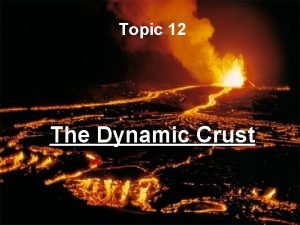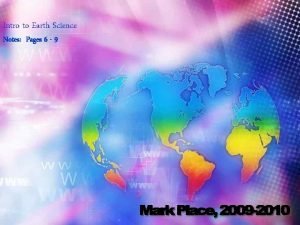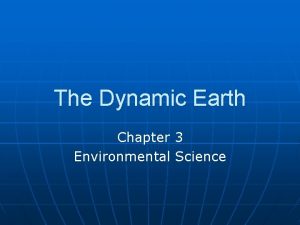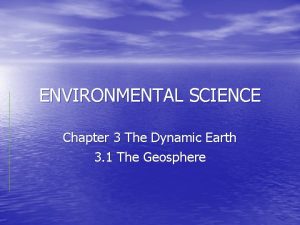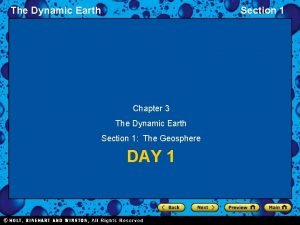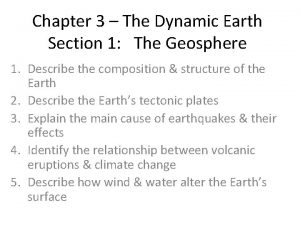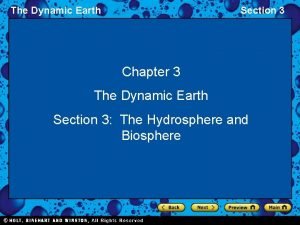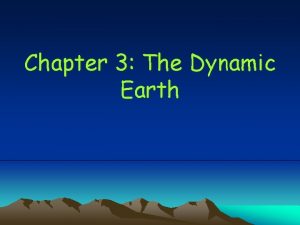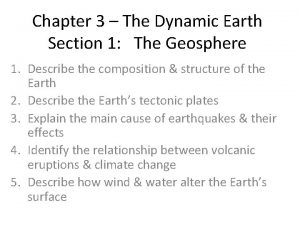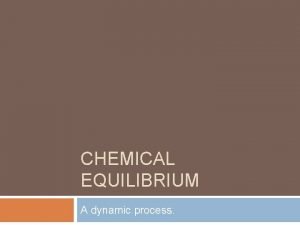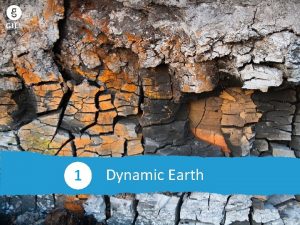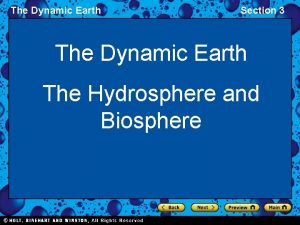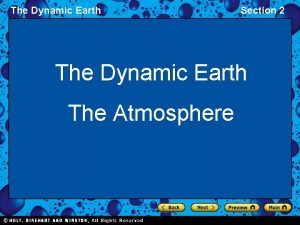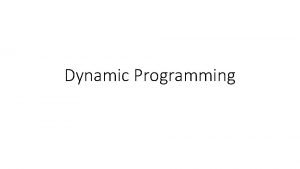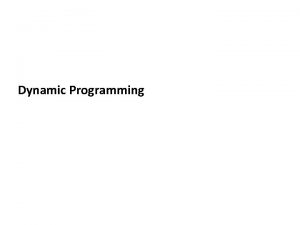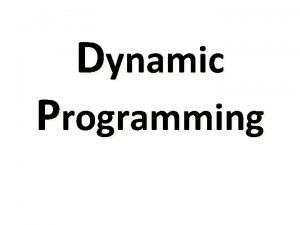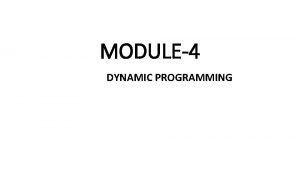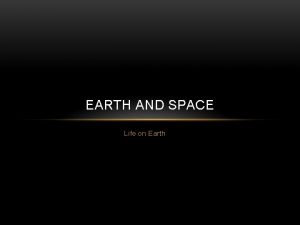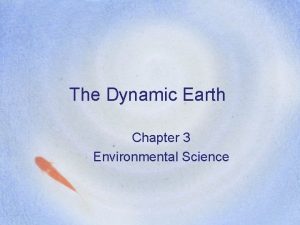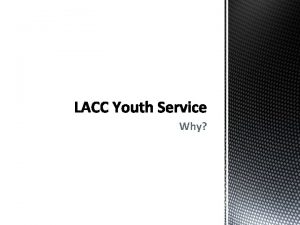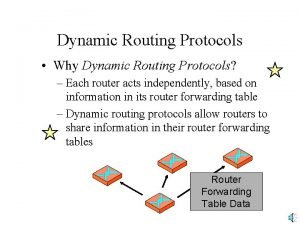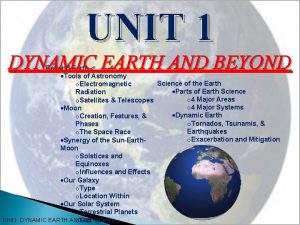The Dynamic Earth Why is the Earth not

























































- Slides: 57

The Dynamic Earth

Why is the Earth not flat? • Or other questions such as – Why are the continents where they are? – Why are they the shapes they are – Why are there mountains? How are they formed? • In 1912 Alfred Wegener proposed the Theory of Continental Drift – Pangea (all lands) and Panthalassa (single ocean)

Evidence • Puzzle pieces – Africa and South America seem to “fit” together • Fossils – Eg. Mesosaurus (270 M years ago)


Evidence • Geological – Age and type of rock formations – Appalachians and similar mountains in Scotland northern Europe • Climate changes – Evidence of glaciation in S. A and Africa – Coal deposits in US, Europe and Siberia

Mechanisms • WW II introduced sonar – noticed that the ocean floor was not flat • 1947 started mapping the Mid-Atlantic Ridge – part of a series of mid ocean ridges that extends around the world – rock they brought up was younger than continental rocks – none more than about 170 M years old

Mechanisms • sea floor spreading – Harry Hess suggested theory/hypothesis that the valley at the center of the ridge was actually a rift or break in the Earth’s crust and that new rock was welling up from deep within the Earth

Mechanisms • Paleomnagnetism – As magma rising from the mantle cools, any magnetic mineral particles in it orient themselves to align with the Earth’s magnetic field – Scientists examined the cores from the ocean floor and found rocks with magnetic orientation pointing south, not north – When the rocks were dated it was found that those with the same magnetic variations were the same ages – The pattern was the same on each side of the ridge

Mechanisms • Paleomagnetism con’t – The intervals were not of the same length each time making the pattern unique – 1965 scientists finally accepted that the Earth’s magnetic pole does regularly reverse itself • How does Iceland provide good evidence for this theory?


Plate Tectonics • Is the name given to the modern theory that is based on Wegener’s original idea but that now incorporates so much more • This theory is not just about the continental plates moving but also includes the mechanisms that drive this movement – This explains the formation of many features of the Earth’s crust

Plate tectonics • There are two types of crust – Oceanic crust and continental crust • The two crusts combine to form the lithosphere – the thin outer shell of the Earth • This rides over the asthenosphere which is the layer of liquid or plastic rock that flows under pressure

Plate tectonics • The plates of the lithosphere ride on the more fluid asthenosphere – Most plates are made up of oceanic and continental crust – About 30 plates have been identified and they vary is size • How the plates interact with each other has created the major surface features of the Earth

The major plates

Types of Plate Boundaries


Divergent Boundary • Two plates moving away from each other • When this happens the gap is filled with material from the asthenosphere • Rift valleys form where • The Mid-Atlantic ridge the plates separate, for is one example (all example Red Sea, Great ocean ridges are Rift Valley (Kenya) divergent)


Composite heat-flow model obtained by merging age-dependent model heat-flow from Stein & Stein [1992]. Color scale is selected to show detail in continental areas of relatively low heat-flow. All spreading ridges were assigned uniform 0. 3 W/m 2 conductive heat flow along their centers.

Divergent plates • Mid ocean rift valleys are typically broken into segments called fracture zones – These are perpendicular to the ridge • Movement along the fracture zones are a major cause of earthquakes along mid ocean ridges

Divergent plates • Mid ocean ridges are also the location for hydrothermal vents on the ocean floor that contain formerly unknown life forms who ecology is based on chemosynthesis and not photosynthesis

Convergent Boundaries • These are plates that are colliding with each other • Three different possibilities exist to deal with the excess of material at a single location -Subduction boundaries -Ocean trenches and Island arcs -Collision boundaries

Subduction boundaries • This creates a region • This occurs when known as a subduction oceanic crust zone converges with continental crust • Oceanic crust is denser so it is subducted or forced beneath the lighter continental crust

Subduction zones • Other consequences of subduction include the formation of volcanoes and island arcs

Volcano formation • When the ocean crust moves under the continental crust heat and pressure plus ocean water cause the solid material to melt • For this reason chain of volcanoes are often found associated with convergent plates. – One of the best known examples is the Pacific “Ring of Fire” – Costal mountains in North America such as Mount St. Helens



Ocean Trenches • These are created where plates converge and are some of the deepest places on the planet – E. g Marianna Trench off the coast of the Marianna Islands near Japan – 11, 000 m or 36, 000 ft or over 6. 5 miles deep


Island arcs • These are formed when the volcanoes at the subduction zone are not under a continent but instead form a ring of volcanic islands. • Examples – Aleutian Islands, Japan, Philippines, Indonesia

Collision Boundaries • When two continental crusts converge the material cannot be subducted instead the continental masses pile on top of each other forming mountain ranges • Himalayas, Rocky Mountains etc.

The Himalayas


Rocky Mountains

Transform Boundaries • This occurs when two • Movement tends to be plates are moving past in a series of jerks, each other often released with • Since this not a smooth great force, known as passing they tend to earthquakes grind against each other • Pressure builds up as the plates scrape past each other

Transform Boundaries • The San Andreas fault • Mid ocean fractures is one of the best are also examples of known due to its transform boundaries. location in such populated areas in California • It moves at about 5 cm year in some areas • Some have not moved in over 100 years San Francisco 1906


San Andreas Fault


Mechanism of plate motion • Convection is considered the most likely mechanism that causes plates to move • There are three possible hypotheses that may account for these movements – Mantle convection – Ridge push – Slab pull

Mantle convection • Magma that is hotter • Cooler plate material sinks down at a and less dense than its surroundings rises subduction boundary upwards at a mid– This balances out the ocean ridge new material being produced at the mid • This creates one side ocean ridge of a convection cell • As it moves it drags • This hypothesis may not the lithospheric plate explain the enormous force needed to move with it. the plates


Ridge push • As new magma rises at the mid-ocean ridge it is less dense and floats • As it cools it becomes more dense and gravity causes it to slide away from the ridge and new molten magma rises • Computer models suggest that cooling subsiding rock could help drive plate movement – called ridge push

Slab pull • At subduction boundaries one plate is denser and heavier than the other • Since this is heaver and cooler than the mantle it continues to sink pulling the rest of the plate with it. • The force of sinking edge exerts on the rest of the plate is called slab pull.


Plate tectonics and Supercontinents • About 250 million years ago all the continents were formed into one landmass • Previous combined landmasses had existed – Data for many is reduced to evidence from cratons – The ancestors to the modern continents were smaller and land mass has increased over time • Whether surface rock is increasing, decreasing or constant is not certain at this time • Once complete super continent cycle takes 300 – 500 million years

Plate tectonics and Supercontinents • The oldest ocean floor is about 170 m years but the oldest rock is dated to 4 b years ago. • This means that knowing the history of landmasses comes from piecing together geological bits – either cratons (core continental rock) or terranes (from collisions) • Deep sea and river sediments and igneous rock also help build continents

Laurentia, the North American Craton • Some of the oldest rock in the world is found here (3. 96 b yrs) • The craton shows the approximate shape 1 b yrs ago • The exposed parts are known as Canadian Shield, the rest is covered by sediment

Previous continents • Nena – about 1. 8 b yrs • ago • Columbia (also called • Nuna) – about 1. 8 - 1. 5 b yrs ago • • Rodinia –about 1. 1 b - 750 m years ago) • Pannotia – about 600 - • 540 m years ago Euramerica – about 300 m years ago Pangea – about 300 180 m years ago Laurasia – about 300 60 m years ago Gondawana- about 600 -30 m years ago

Supercontinent breakup • Pangea broke into two smaller masses called Gondwana and Laurasia about 180 m yrs ago • Over time each of these broke up into smaller landmasses who shapes began to resemble present continents.


Microplate terranes • A terrane is a piece of lithospheric plate with a unique geological history – This will include rock types, fossils, faults, folds, magnetic properties etc. • For example, there are over 10 different terranes in northern California!

Ancient terrane distributions Terranes on Cuba

Deep Sea sediments • These can be added to the edges of a continent when an oceanic plate plunges under a continental plate and sediment from the ocean floor is scraped off and left behind on the edge of the continent

Igneous rock • Magma that rises to the surface and cools adds new rock to the continent • Volcanoes add rock mass at the edges of continents along subduction zones • Volcanic islands (island arcs) may become part of the continent due to plate movements

River sediment • Material deposited by river sediments that flow across continents can extend the edges of continents – The Mississippi River is doing this right now at the edge of the North American continent

Landsat TM false-color image of the modern Mississippi Delta. Pink and red depict active, emergent vegetation; cyan shows water rich in suspended sediment (mud); dark blue to black is relatively clear water. Image obtained from NASA
 Andreas carlsson bye bye bye
Andreas carlsson bye bye bye English 9 vocabulary unit 1
English 9 vocabulary unit 1 Does this table represent a function why or why not
Does this table represent a function why or why not Does this table represent a function why or why not
Does this table represent a function why or why not Why or why not
Why or why not Dont ask why why why
Dont ask why why why Dynamic dynamic - bloom
Dynamic dynamic - bloom Earth's dynamic crust and interior topic 12
Earth's dynamic crust and interior topic 12 Dynamic equilibrium earth science
Dynamic equilibrium earth science Chapter 3 the dynamic earth
Chapter 3 the dynamic earth Chapter 3 the dynamic earth
Chapter 3 the dynamic earth Dynamic earth structure
Dynamic earth structure The dynamic earth chapter 3
The dynamic earth chapter 3 Chapter 3 the dynamic earth
Chapter 3 the dynamic earth Chapter 3 the dynamic earth section 1 the geosphere
Chapter 3 the dynamic earth section 1 the geosphere The dynamic earth chapter 3
The dynamic earth chapter 3 John wright character analysis
John wright character analysis Dynamic process chemistry
Dynamic process chemistry Dull would he be of soul who could pass by figure of speech
Dull would he be of soul who could pass by figure of speech Hát kết hợp bộ gõ cơ thể
Hát kết hợp bộ gõ cơ thể Ng-html
Ng-html Bổ thể
Bổ thể Tỉ lệ cơ thể trẻ em
Tỉ lệ cơ thể trẻ em Chó sói
Chó sói Thang điểm glasgow
Thang điểm glasgow Alleluia hat len nguoi oi
Alleluia hat len nguoi oi Các môn thể thao bắt đầu bằng tiếng bóng
Các môn thể thao bắt đầu bằng tiếng bóng Thế nào là hệ số cao nhất
Thế nào là hệ số cao nhất Các châu lục và đại dương trên thế giới
Các châu lục và đại dương trên thế giới Công của trọng lực
Công của trọng lực Trời xanh đây là của chúng ta thể thơ
Trời xanh đây là của chúng ta thể thơ Mật thư tọa độ 5x5
Mật thư tọa độ 5x5 Làm thế nào để 102-1=99
Làm thế nào để 102-1=99 Phản ứng thế ankan
Phản ứng thế ankan Các châu lục và đại dương trên thế giới
Các châu lục và đại dương trên thế giới Thể thơ truyền thống
Thể thơ truyền thống Quá trình desamine hóa có thể tạo ra
Quá trình desamine hóa có thể tạo ra Một số thể thơ truyền thống
Một số thể thơ truyền thống Cái miệng nó xinh thế chỉ nói điều hay thôi
Cái miệng nó xinh thế chỉ nói điều hay thôi Vẽ hình chiếu vuông góc của vật thể sau
Vẽ hình chiếu vuông góc của vật thể sau Biện pháp chống mỏi cơ
Biện pháp chống mỏi cơ đặc điểm cơ thể của người tối cổ
đặc điểm cơ thể của người tối cổ V cc cc
V cc cc Vẽ hình chiếu đứng bằng cạnh của vật thể
Vẽ hình chiếu đứng bằng cạnh của vật thể Phối cảnh
Phối cảnh Thẻ vin
Thẻ vin đại từ thay thế
đại từ thay thế điện thế nghỉ
điện thế nghỉ Tư thế ngồi viết
Tư thế ngồi viết Diễn thế sinh thái là
Diễn thế sinh thái là Các loại đột biến cấu trúc nhiễm sắc thể
Các loại đột biến cấu trúc nhiễm sắc thể Thế nào là số nguyên tố
Thế nào là số nguyên tố Tư thế ngồi viết
Tư thế ngồi viết Lời thề hippocrates
Lời thề hippocrates Thiếu nhi thế giới liên hoan
Thiếu nhi thế giới liên hoan ưu thế lai là gì
ưu thế lai là gì Khi nào hổ con có thể sống độc lập
Khi nào hổ con có thể sống độc lập Khi nào hổ mẹ dạy hổ con săn mồi
Khi nào hổ mẹ dạy hổ con săn mồi







